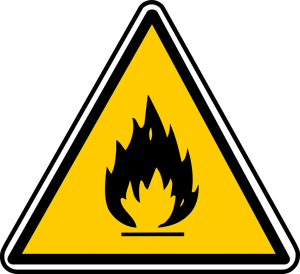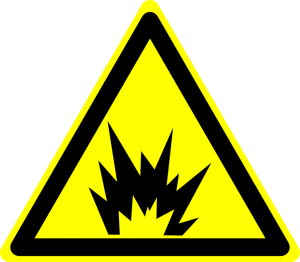Guest Author: Olusegun Bamiduro Updated February 18, 2025

Cement and concrete manufacturing is a vital industrial activity across the continent of Africa and in many other countries throughout the world. Growth in demand for cement and concrete continues to remain strong as government and private sectors focus on infrastructure and housing development.
Fire and explosion hazards arise due to the nature of several processes occurring during the cement and concrete manufacturing process and the raw materials being used. Besides property damage resulting from fires and explosions, these accidents can cause injuries and fatalities to workers. Therefore, understanding hazard prevention is important in the cement industry.
Is Cement Flammable? No, common cements are not flammable. Cement is a non-combustible and non-explosive material, meaning it does not ignite or sustain combustion. However, cement dust in certain industrial environments can pose explosion risks due to airborne particles and interactions with combustible materials as a hybrid dust mix.
This article outlines the various fire and explosion hazards present in the cement and concrete manufacturing industries and the cement and concrete manufacture process. A description of the cement and concrete manufacturing process is given followed by five typical fire hazards. Cement dust and silica dust occupational exposure, health hazards, and five explosion hazards in the cement industry are also reviewed.
If you have any comments or questions regarding a fire and explosion hazard, leave them in the comment section at the bottom of the page. We would be happy to hear from you!
Cement Manufacturing Process
The cement and concrete manufacture process typically involves quarrying, drying & grinding, kiln burning & cooling, finish grinding, and packaging, and concrete cutting, creating high levels of dust, cement dust and cement dust exposure. Each of these process steps is described in the following sections.
Step #1: Quarrying
Quarrying involves the mining of limestone, (calcium oxide) . This includes crushing the raw material and transporting the raw material to the factory through conveyors or roads. Approximately 1.6 tonnes of limestone are needed for every 1 tonne of cement, and therefore the availability of limestone is an important parameter in locating the cement plant.
Step #2: Drying & Grinding
The crushed rock obtained from quarries is taken to a mix bed plant where the raw material components are pre-homogenized, dried, and ground, creating high levels of dust, cement dust, cement dust exposure, cement dust exposed workers, and silica dust.
Raw materials generally contain moisture and need to be dried before or during the grinding process. The heat for drying is typically supplied by waste gases from the rotary kiln or clinker cooler. For grinding, large cement plants use high speed roller mills or bowl type grinding mills, and smaller plants use tube mills packed with paper bags filled with iron grinding balls, creating cement dust and silica dust.
Step #3: Kiln Burning & Cooling
Raw mix is transported hydraulically to an air separator. Here the mix is separated into coarse and fine particles. Coarse material is returned to the grinding mill and fine particles (raw mix) are blended in homogenizing silos.
Homogenization takes places when the air entering the bottom of the kiln passes through the raw mix fed from above. Raw mix is heated up to 800C by kiln waste gases in a multi-stage cyclone pre-heater before it enters the kiln. The pre-calciner in the lower part of the pre-heater almost entirely calcinates the raw mix. The raw mix passes through various reaction zones due to the rotation of the inclined kiln.
The various reaction zones in the inclined kiln include: the inlet or preheating zone, the calcinating zone where the raw mix gets split up at a temperature between 1050C – 1150C, and the burning zone where lime reacts with clay and sand at a temperature between 1250C – 1450C. This results in partial melting and the formation of granular clinker. The length of each zone depends on the composition of raw material, the type of rotary kiln, and the cooling system employed. The clinker formed in the kiln drops into the clinker cooler where it gets cooled to a temperature between 120C to 200C. From here clinker is shifted to an intermediate storage silo through conveyors.
Step #4: Finish Grinding
Clinker granules from the storage silos are conveyed to the cement mill where they are ground with additives like gypsum to make cement. Grinding is most frequently carried out in tube mills through rolling and grinding elements which reduce the grinding stock to powder. Ground cement is then transferred to silos for storage through conveyors, creating more high levels of dust, cement dust, cement dust exposure, and silica dust.
Step #5: Packaging & Loading
Packaging and loading stations with weighing devices are used in bagging, packing, and transferring the cement to trucks creating cement dust and cement dust exposure. These are dispatched to the end destination in individual bags or as bulk transfer.
Fire Hazards
Five fire hazards associated with the cement manufacturing process are outlined in the following sections.
1) Coal Storage

On average 0.2 – 0.3 tonnes of coal are consumed in the kiln per kilogram of clinker cement production. As such coal storage during cement manufacturing is an important component to consider in hazard analysis.
Among the various causes of coal fires, spontaneous combustion during storage results in a large number of losses. Spontaneous combustion is caused by adsorption of oxygen at the outer and inner surface of coal which results in oxidation. Oxidation is an exothermic reaction that causes the temperature of the coal stack to rise gradually. As the pile exceeds approximately 800C ignition can occur. Spontaneous combustion of coal depends on many factors and critical among these is the type, age and composition of coal.
2) Coal Conveying
The combustible nature of crushed coal poses a fire hazard in the conveying system. Frictional resistance between idlers and rollers, insufficient lubrication, belt misalignment, and faulty bearings can generate sparks or heat, which can ignite the crushed coal, creating coal dust.
3) On-Site Power Plants
Cement manufacturing is a very energy intensive process. As such, on-site power plants are increasingly being used to meet the energy demands of the cement plant.
Some of the fire hazards associated with on-site power plants include fire in power house buildings due to the ignition of lube oil. Fuel oil fires and fires in the power plant boiler can also occur, as well as cable gallery fires.
4) Electrical Equipment & Cables
Cement plants are energy intensive industries and have a large number of heavy duty electrical equipment used for distribution, control, and electric power utilization. Large quantities of insulation oil used in equipment like switchgears, transformers, and capacitors are combustible in nature and pose a major fire hazard. A Fire hazard also arise from large-scale electrical cabling carried out between various substations and equipment.
Various modifications and capacity enhancements may occur in the cement plant over time, requiring the installation of new cable layouts. This can give rise to multiple cable joints which decreases fire safety. Since most of these substations are unmanned this can increase the fire risk.
5) Empty Bag Storage
Lastly, storage of empty bags are a large fire hazard due to the combustible nature of the material used. Fires in bag storage areas can spread to adjoining areas in the plant like the cement bagging station, increasing the potential loss of these fires.
Explosion Hazards
In addition to a fire hazard, there are several explosion hazards that can arise in cement manufacturing. Five of these potential explosion hazards are listed in the following.
1) Coal Pulverizing

Coal is often the main fuel source used to heat the cement kiln. Coal pulverizers are required to grind the coal from the bulk storage size to a smaller particle diameter to use in the kiln.
Coal pulverizers significantly reduce the mean particle size of the coal, drastically increasing the fire/explosion hazard risk. This risk is present inside the pulverizing equipment and during transport to the kiln for burning.
2) Bag Filters
Fire and explosion hazards in bag filters can arise due to any of the following factors: spontaneous combustion, dust explosion, static electricity, and high temperature materials passing through the filters. Bag filters used for the coal mill rank as one of the highest fire and explosion hazards in cement plants, due to the small particle size of the crushed coal.
3) Electrostatic Precipitators
The build-up of explosive mixtures like finely dispersed coal dust in the air, or carbon monoxide in the air can result in an explosion hazard in Electrostatic Precipitators. As such, special care is required at these locations to prevent such a build-up.
4) Storage and Handling of Explosives
Most cement plants own limestone quarries that are located nearby. Limestone quarrying involves the use of explosives and as such, it is vital that they are stored and handled in a safe manner to avoid unexpected detonation.
5) Power Plant Boilers
Lastly, the boilers used in the on-site power plants require special care to avoid an explosion hazard. Routine inspection and maintenance should be used when operating these systems.
Summary
This article outlined five fire hazards and five explosion hazards present during cement manufacturing and processing operations, and cement exposed workers, that are statistically significant. The activities of process safety experts include analyzing, designing, and implementing measures to prevent and mitigate these health and safety hazards, for the safe operation of cement manufacturing facilities, both short term and long term.
Another health and safety issue that was briefly mentioned in this article, and is important to consider is a respiratory hazard, with shortness of breath, and other occupational diseases to lung function, from exposure to cement. Dusty environments and concrete cutting, can be present in the cement industry, exposing cement plant workers and cement factory workers, to high levels of dust, which contain respirable crystalline silica, causing chronic respiratory symptoms.
In addition, cement industry workers and portland cement factory workers, and construction workers can be exposed to various health complications and health risks. Of these, inhalation of excess amounts of cement dust is a critical concern, depending on length of work experience exposure to cement, both short term or long term. Cement dust exposure can cause lung function impairment, chronic obtrusive lung disease, chronic obstructive pulmonary disease, restrictive lung disease, shortness of breath, lung cancer, pneumoconiosis of the lungs, squamous metaplasia, stomach cancer and colon cancer. Wet cement is highly alkaline. A serious burn or ulcer can rapidly develop if wet cement is trapped against the skin. Wet cement can collect under jewelry such as rings and watches. Studies show that cement dust can enter into systemic circulation and reach various body organs including the heart, liver, spleen, bone, muscles and hair, which may affect their micro-structure and physiological performance.

Mr. Olusegun Bamiduro is Project Director/Business Development Lead at Firecraft Safety & Engineering Services Ltd. in Surulere, Lagos, Nigeria and is a local agent of Firefly AB of Sweden in the Nigeria Market. Olusegun has over 20 years experience in fire prevention, explosion protection, and blast engineering and specializes in passive fire protection in civil, oil & gas, and agriculture industries.
